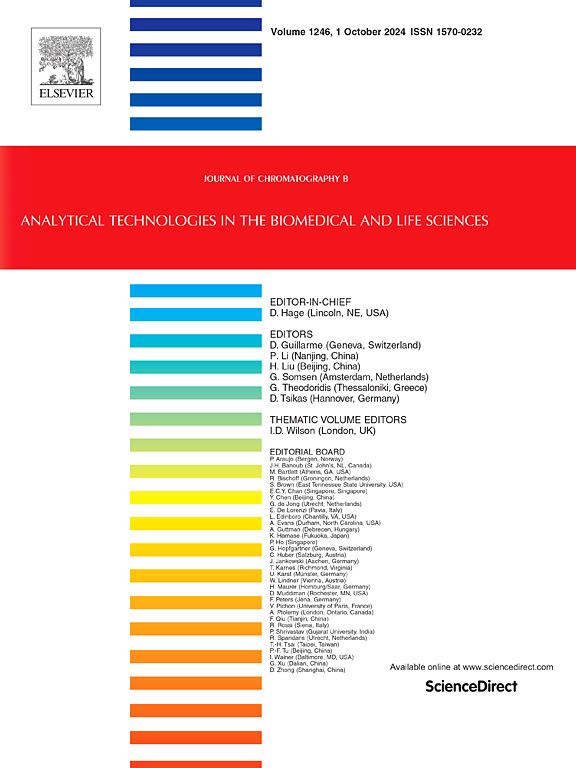GC–MS metabolomics coupled with multi-biomarker analysis reveal toxic effects of functionalized nanoplastics in Paphia undulata
IF 2.8
3区 医学
Q2 BIOCHEMICAL RESEARCH METHODS
引用次数: 0
Abstract
Despite the widespread occurrence of nanoplastics (NPs) in marine ecosystems, a knowledge gap persists regarding their bioaccumulation and toxic effects in marine bivalves, particularly for NPs with surface modifications. This study employed combined metabolomics and multi-biomarker analyses to investigate the bioaccumulation, elimination, and toxicity of pristine polystyrene (PS), carboxylated PS (PS-COOH), and aminated PS (PS-NH₂) NPs in marine clam Paphia undulata. Results revealed distinct tissue-specific accumulation patterns, showing highest NP uptake in intestines (109.34 μg/g), followed by digestive glands (30.36 μg/g), with minimal uptake in gills (7.47 μg/g). Following a 4-day exposure, NPs triggered tissue-specific antioxidant responses, inducing significant oxidative damage (elevated malondialdehyde) in digestive glands. PS-NH₂ activated the superoxide dismutase (SOD) and glutathione (GSH) systems, while PS and PS-COOH elicited synergistic upregulation of SOD and catalase (CAT) activities, indicating surface chemistry-dependent detoxification pathways. GC–MS-based metabolomics revealed that NPs markedly disrupted metabolic homeostasis in digestive glands. Significant alterations occurred in carbohydrates, amino acids, lipids, and organic acids, with PS-COOH exposure yielding the most differential metabolites (PS-COOH: 27, PS: 21, PS-NH₂: 20). Pathway enrichment analysis showed all NPs interfered galactose metabolism and starch/sucrose metabolism, disrupting energy homeostasis. Additionally, PS dysregulated phenylalanine, tyrosine and tryptophan biosynthesis, whereas PS-COOH perturbed cysteine and methionine metabolism, demonstrating surface chemistry-specific dysregulation of distinct amino acid pathways. This work provides mechanistic insights into how NP surface chemistry modulates toxicity in marine bivalves. The integration of biomarker responses with metabolome perturbations offers a systematic framework for evaluating NP ecotoxicity, informing ecological risk assessments for marine benthic ecosystems.
GC-MS代谢组学结合多生物标志物分析揭示了功能化纳米塑料对波波帕菲亚的毒性作用。
尽管纳米塑料(NPs)在海洋生态系统中广泛存在,但关于其在海洋双壳类动物中的生物积累和毒性作用的知识差距仍然存在,特别是对表面修饰的NPs。本研究采用代谢组学和多生物标志物分析相结合的方法,研究了原始聚苯乙烯(PS)、羧化PS (PS- cooh)和胺化PS (PS- nh₂)NPs在波状帕菲亚蛤中的生物积累、消除和毒性。结果显示出明显的组织特异性积累模式,肠道的NP吸收量最高(109.34 μg/g),其次是消化腺(30.36 μg/g),鳃的吸收量最低(7.47 μg/g)。暴露4天后,NPs引发组织特异性抗氧化反应,在消化腺中诱导显著的氧化损伤(丙二醛升高)。PS- nh 2激活了超氧化物歧化酶(SOD)和谷胱甘肽(GSH)系统,而PS和PS- cooh诱导了SOD和过氧化氢酶(CAT)活性的协同上调,表明了表面化学依赖的解毒途径。基于gc - ms的代谢组学显示,NPs显著破坏了消化腺的代谢稳态。碳水化合物、氨基酸、脂质和有机酸发生了显著的变化,PS- cooh暴露产生的代谢物差异最大(PS- cooh: 27, PS: 21, PS- nh: 20)。途径富集分析表明,所有NPs干扰了半乳糖代谢和淀粉/蔗糖代谢,破坏了能量稳态。此外,PS失调苯丙氨酸、酪氨酸和色氨酸的生物合成,而PS- cooh则扰乱了半胱氨酸和蛋氨酸的代谢,表明了不同氨基酸途径的表面化学特异性失调。这项工作为NP表面化学如何调节海洋双壳类动物的毒性提供了机制见解。生物标志物反应与代谢组扰动的整合为评估NP生态毒性提供了一个系统框架,为海洋底栖生态系统的生态风险评估提供了信息。
本文章由计算机程序翻译,如有差异,请以英文原文为准。
求助全文
约1分钟内获得全文
求助全文
来源期刊

Journal of Chromatography B
医学-分析化学
CiteScore
5.60
自引率
3.30%
发文量
306
审稿时长
44 days
期刊介绍:
The Journal of Chromatography B publishes papers on developments in separation science relevant to biology and biomedical research including both fundamental advances and applications. Analytical techniques which may be considered include the various facets of chromatography, electrophoresis and related methods, affinity and immunoaffinity-based methodologies, hyphenated and other multi-dimensional techniques, and microanalytical approaches. The journal also considers articles reporting developments in sample preparation, detection techniques including mass spectrometry, and data handling and analysis.
Developments related to preparative separations for the isolation and purification of components of biological systems may be published, including chromatographic and electrophoretic methods, affinity separations, field flow fractionation and other preparative approaches.
Applications to the analysis of biological systems and samples will be considered when the analytical science contains a significant element of novelty, e.g. a new approach to the separation of a compound, novel combination of analytical techniques, or significantly improved analytical performance.
 求助内容:
求助内容: 应助结果提醒方式:
应助结果提醒方式:


